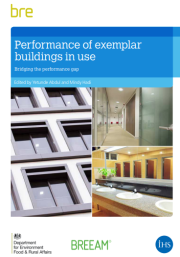Performance of exemplar buildings in use: Bridging the performance gap FB 78
BRE (Building Research Establishment) is an independent, research-based consultancy, testing and training organisation, operating in the built environment and associated industries.
Performance of exemplar buildings in use: Bridging the performance gap (FB 78) was edited by Yetunde Abdul and Mindy Hadi and published by BRE on 17 February 2016.
The 32-page report reviews the operational performance of three public-sector office buildings that were designed to achieve energy and water efficiency (although many of the lessons learned are equally applicable to the private sector).
It is based on a study carried out in 2010–2012, funded by BRE Trust, the Cabinet Office and the Department for Environment, Food and Rural Affairs (Defra), which highlighted the benefits and challenges of environmental design in relation to the building handover process and the management of facilities.
All of the buildings were completed between 2005 and 2008, allowing enough time for the systems to bed down and for the building managers and FM teams to become familiar with managing them. They were designed to achieve an Excellent rating based on the version of BREEAM used at the time. They were reviewed for their energy and water consumption, and consumption trends were analysed. Feedback on their general operational performance was gathered from public-sector staff and their facilities management teams.
The report reviews the issues faced by designers, clients and building managers in bridging the gap between the designed performance and the actual operational performance of buildings over their lifetime.
The contents of the report are:
- Executive summary.
- Introduction.
- Background.
- Analysing data for the case study buildings.
- Case study 1.
- Case study 2.
- Case study 3.
- Summary of environmental performance for the case studies.
- Summary of issues identified and lessons learned.
- Outcomes and conclusions.
- Discussion.
- Moving forward: tools and initiatives.
- References.
[edit] Related articles on Designing Buildings Wiki
- BRE articles on Designing Buildings Wiki.
- BRE Buzz articles on Designing Buildings Wiki.
- BRE Buzz.
- BREEAM.
- Building performance evaluation programme.
- Building performance evaluation.
- Building Research Establishment.
- Building use studies (BUS).
- Closing the gap between design and as-built performance.
- Performance gap.
- Performance in use.
- Post occupancy evaluation.
- Post project review.
- QUANTUM project.
- Soft landings.
Featured articles and news
RTPI leader to become new CIOB Chief Executive Officer
Dr Victoria Hills MRTPI, FICE to take over after Caroline Gumble’s departure.
Social and affordable housing, a long term plan for delivery
The “Delivering a Decade of Renewal for Social and Affordable Housing” strategy sets out future path.
A change to adoptive architecture
Effects of global weather warming on architectural detailing, material choice and human interaction.
The proposed publicly owned and backed subsidiary of Homes England, to facilitate new homes.
How big is the problem and what can we do to mitigate the effects?
Overheating guidance and tools for building designers
A number of cool guides to help with the heat.
The UK's Modern Industrial Strategy: A 10 year plan
Previous consultation criticism, current key elements and general support with some persisting reservations.
Building Safety Regulator reforms
New roles, new staff and a new fast track service pave the way for a single construction regulator.
Architectural Technologist CPDs and Communications
CIAT CPD… and how you can do it!
Cooling centres and cool spaces
Managing extreme heat in cities by directing the public to places for heat stress relief and water sources.
Winter gardens: A brief history and warm variations
Extending the season with glass in different forms and terms.
Restoring Great Yarmouth's Winter Gardens
Transforming one of the least sustainable constructions imaginable.
Construction Skills Mission Board launch sector drive
Newly formed government and industry collaboration set strategy for recruiting an additional 100,000 construction workers a year.
New Architects Code comes into effect in September 2025
ARB Architects Code of Conduct and Practice available with ongoing consultation regarding guidance.
Welsh Skills Body (Medr) launches ambitious plan
The new skills body brings together funding and regulation of tertiary education and research for the devolved nation.
Paul Gandy FCIOB announced as next CIOB President
Former Tilbury Douglas CEO takes helm.
UK Infrastructure: A 10 Year Strategy. In brief with reactions
With the National Infrastructure and Service Transformation Authority (NISTA).
























